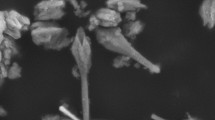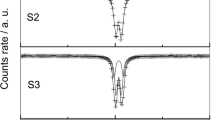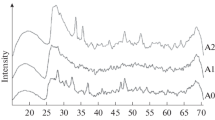Abstract
Diffractograms of lepidocrocites formed from the oxidation of Fe(II) chloride solutions at pH 7 and 25°C showed differential line broadening with (0k0) reflections being much sharper than (hk0) or (hkl). As the initial [Cl]/[Fe] ratio was increased from 2, crystallinity increased in all axial directions, as defined by the width at half height of diffraction peaks. At [Cl]/[Fe] ratios greater than ~8, the crystallinity did not increase further, and for reflections involving the a-axis direction, it appeared to decrease. Increased [Cl]/[Fe] ratios changed the rate of the oxidation/hydrolysis reactions. These variations reflect changes in the stability and/or composition of the intermediate green rust phase, (Fe(II)Fe(III) hydroxychloride) in the high [Cl] environment. The influence of the [Cl]/[Fe] ratio was related to the experimental conditions employed, especially where they influenced the rate of oxidation.
Resümee
Diffraktogramme von Lepidokrokiten, die durch die Oxidation von Fe(II)chlorid-Lösungen bei pH 7 und 25°C gebildet wurden, zeigten differentielle Linienverbreiterung, wobei die (0k0)-Reflexe viel schärfer waren als die (hk0)- oder (hkl)-Reflexe. Wenn das ursprüngliche [Cl]/[Fe]-Verhältnis von 2 ausgehend erhöht wurde, nahm die Kristallinität in allen Achsenrichtungen zu, wie die Breite bei halber Peakhöhe der Diffraktometerpeaks zeigte. Bei [Cl]/[Fe]-Verhältnissen über ~8 nahm die Kristallinität nicht weiter zu. Bei Reflexen, die die Richtung der a-Achse mit einschließen, schien die Kristallinität sogar abzunehmen. Erhöhte [Cl]/[Fe]-Verhältnisse veränderten die Geschwindigkeit der Oxidation/Hydrolyse-Reaktionen. Diese Schwankungen spiegeln Veränderungen in der Stabilität und/oder in der Zusammensetzung der Übergangsphase grüner Rost (Fe(II)Fe(III)-hydroxychlorid) in dem [Cl]-reichen Milieu wieder. Der Einfluß des [Cl]/[Fe]-Verhältnisses wurde zu den gegebenen experimentellen Bedingungen in Beziehung gesetzt, insbesondere dort, wo sie die Oxidationsgeschwindigkeit beeinflußten. [U.W.]
Résumé
Des diffractogrammes de lépidocrocites formés à partir de l’oxidation de solutions de chloride Fe(II) au pH 7 et à 25°C ont montré des élargissements de droites différentiels avec les réflections (0k0) beaucoup plus nettes que (hk0) ou (hkl). La cristallinité a augmenté dans toutes les directions axiales propotionnellement à l’augmentation à partir de 2 de la proportion initiale [Cl]/[Fe], par suite de la définition de la demi-hauteur des sommets de diffraction. A des proportions [Cl]/[Fe] plus élevées que ~8, la cristallinité n’a pas augmenté d’avantage, et pour des réflections impliquant la direction de l’axe-a, elle semblait diminuer. Des proportions [CI]/[Fe] augmentées ont changé l’allure des réactions oxidation/ hydrolyse. Ces variations réflètent des changements dans la stabilité et/ou la composition de la phase intermédiaire de rouille verte (hydrochloride Fe(II)Fe(III)) dans l’environement à [Cl] élevé. L’influence de la proportion [Cl]/[Fe] a été apparentée aux conditions expérimentales utilisées, particulièrement dans le cas où elles avaient influencé l’allure de l’oxidation. [D.J.]
Резюме
Дифрактограммы лепидокрокита, формированного путем окисления растворов Fe(II) хлорида при pH = 7 и 25°С, показали расширение дифференциальной линии при отражениях (OkO) более острых, чем (hkO) или (hk/). Если начальное отношение [Cl]/[Fe] увеличивалось от 2, кристалличность увеличивалась по всем осевым направлениям, что видно по ширине дифракционных линий на половине их высоты. При отношениях [Cl]/[Fe] больших, чем ~8, кристалличность дальше не увеличивалась, а для отражений по направлению оси а даже уменьшалась. Увеличенные отношения [Cl]/[Fe] изменяли скорость реакции окисления/гидролиза. Эти изменения указывают на изменения стабильности и/или состава промежуточной фазы зеленой ржавчены (Fe(II)Fe(III) гидроксихлорида) в среде с большим содержанием [Cl]. Влияние отношения [Cl]/[Fe] зависило от использованных экспериментальных условий, особенно, если они влияли на скорость окисления. [E.G.]
Similar content being viewed by others
References
Bernal, J. D., Dasgupta, D. R., and Mackay, A. L. (1959) The oxides and hydroxides of iron and their structural interrelationships: Clay Min. Bull. 4, 15–30.
Christensen, H. and Christensen, A. N. (1978) Hydrogen bonds of γ-FeOOH: Acta Chem. Scand. A32, 87–88.
Ewing, F. J. (1935) The crystal structure of lepidocrocite: J. Chem. Phys. 3, 420–424.
Feitknecht, W. and Keller, G. (1950) Über Hydroxyde und basische Salze des 2 wertigen Eisens und deren dunkelgrüne Oxydationsprodukte: Z. Anorg. Chemie 262, 61–68.
Oleś, A., Szytula, A., and Wanic, A. (1970) Neutron diffraction study of γ-FeOOH: Phys. Stat. Sol. 41, 173–177.
Schwertmann, U., Fitzpatrick, R. W., Taylor, R. M., and Lewis, D. G. (1979) The influence of aluminum on iron oxide. II. Preparation and properties of Al-substituted hematites: Clays & Clay Minerals 27, 105–112.
Taylor, R. M. (1984) The influence of chloride concentration on the oxidation of Fe(II) chloride. I. Effect of [Cl] on the formation of magnetite. Clays & Clay Minerals 32 (in press).
Author information
Authors and Affiliations
Rights and permissions
About this article
Cite this article
Taylor, R.M. Influence of Chloride on the Formation of Iron Oxides From Fe(II) Chloride. II. Effect of [Cl] on the Formation of Lepidocrocite and its Crystallinity. Clays Clay Miner. 32, 175–180 (1984). https://doi.org/10.1346/CCMN.1984.0320303
Received:
Accepted:
Published:
Issue Date:
DOI: https://doi.org/10.1346/CCMN.1984.0320303




